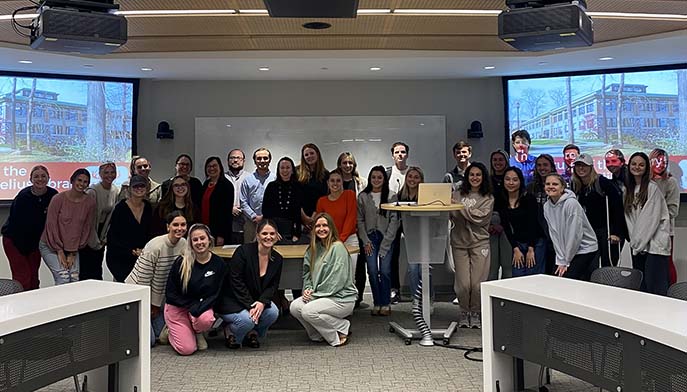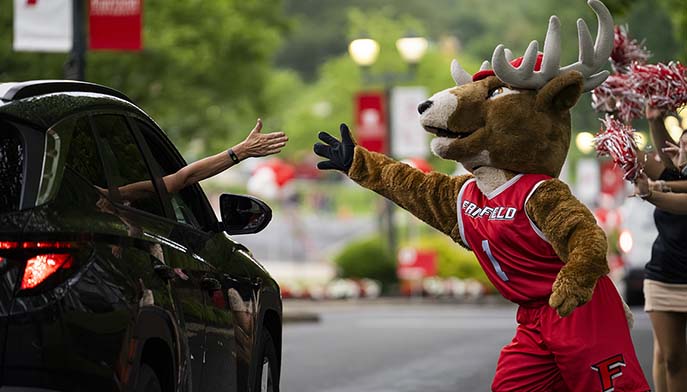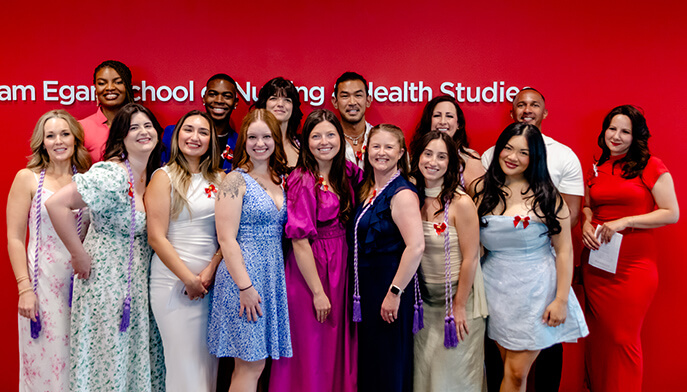Through the Center for Social Impact’s Humanitarian Action program, students presented a Walk in Their Shoes Refugee Experience at Roger Ludlowe Middle School.
On March 2, students in the College of Arts and Sciences’ “Refugee Literature” honors course organized a Walk in Their Shoes Refugee Experience for seventh graders at Roger Ludlowe Middle School in Fairfield. In coordination with the social studies curriculum focused on the Lost Boys of Sudan, the Fairfield University students offered a presentation with hands-on activities to help the middle schoolers understand what life is like for young people in the Kakuma Refugee Camp in Kenya.
“This was the first time a Humanitarian Action class has presented the Walk in Their Shoes Refugee Experience to a local middle school audience,” said Julie Mughal, assistant director of the Humanitarian Action program within the University’s Center for Social Impact. “It was so rewarding to see our students interact with the younger students and explain a complex, difficult issue in a very accessible way.”
Mughal co-teaches “Refugee Literature” with Sabnam Ghosh, PhD, visiting assistant professor of English.
During the Walk in Their Shoes Refugee Experience, the Fairfield undergrads described the Kakuma Refugee Camp as having a population three times the size of the town of Fairfield. They shared that three-quarters of the camp residents are women and children, and that 19 years is the average length of time for refugees to spend there.
Presenting what it’s like to be a refugee in a way that would be relatable to seventh graders helped Courtney Raymond ’26 to think differently about the sheer size of the refugee camps, and about the many parallels that can be drawn between life in camps and life here in the U.S. ”I realized how many things we do every day that are a struggle for refugees — basic things like brushing your teeth or turning on a faucet [for water],” she said.
In one empathy exercise designed to simulate the experience of a 12-year-old refugee, the college students lined up seventh-grade volunteers and had them take turns carrying heavy five-gallon buckets of water across the classroom.
“That wasn’t so bad, was it?” asked one University student.
“But now, imagine having to carry those buckets 190 times over that ten-foot distance. That’s how far a refugee kid carries their family's five-gallon ration of water every day.”
Some of the middle schoolers tested out a portable water filter on a plastic bottle filled with dirty brown water; another group stood inside a six-by-six-foot square taped on the classroom floor and tried to imagine how a family might cope with having to share such tight quarters.
During a comparison between the health, nutrition, and educational opportunities of kids in the U.S. versus those at Kakuma, the college students handed out middle arm circumference bands—a tool to assess malnutrition. When the seventh graders compared their arm measurements to those of a malnourished young person, “one student's jaw was on the floor,” said Raymond. “He was so surprised, and I think it started him making connections and understanding more about the realities of the refugee journey.”
The Fairfield students noted that the application process for resettlement can take up to four years. They described the services available to refugees granted asylum in the U.S., including help with housing, careers, language tutoring, and adjustment to life in a new country. Lastly, the undergrads handed out postcards and offered the middle schoolers a chance to send a handwritten message to a young refugee; the postcards will be mailed for distribution through the Jesuit Refugee Services organization.
“The Fairfield University students were able to put a face on the refugee crisis and emphasized how middle schoolers can play a positive role in taking action,” noted Mughal. “I’m hoping that this experience will make the students aware that they can be agents of change – whether it’s helping to welcome refugees who resettle in our communities or staying informed about the refugee situation and advocating for humane immigration policies.”
Raymond’s favorite part of participating in the presentations was seeing how engaged the Roger Ludlowe students were. “The kids were so curious,” she said. “They asked insightful questions that helped us, as college students, to further reflect based on their perspectives; the kids’ empathy for the refugees really amazed me.”



